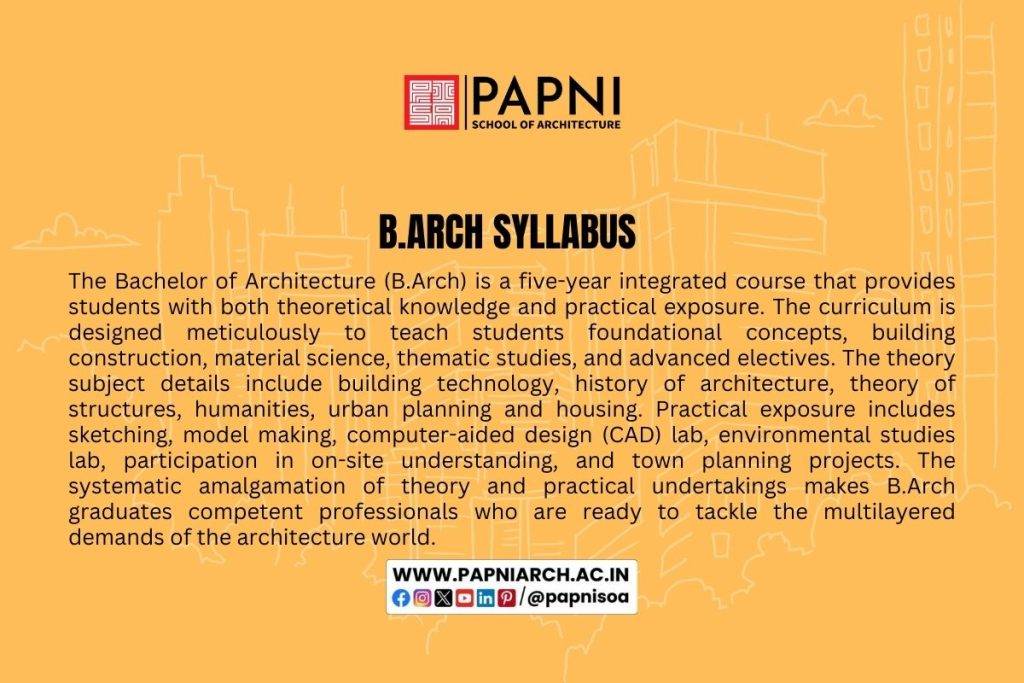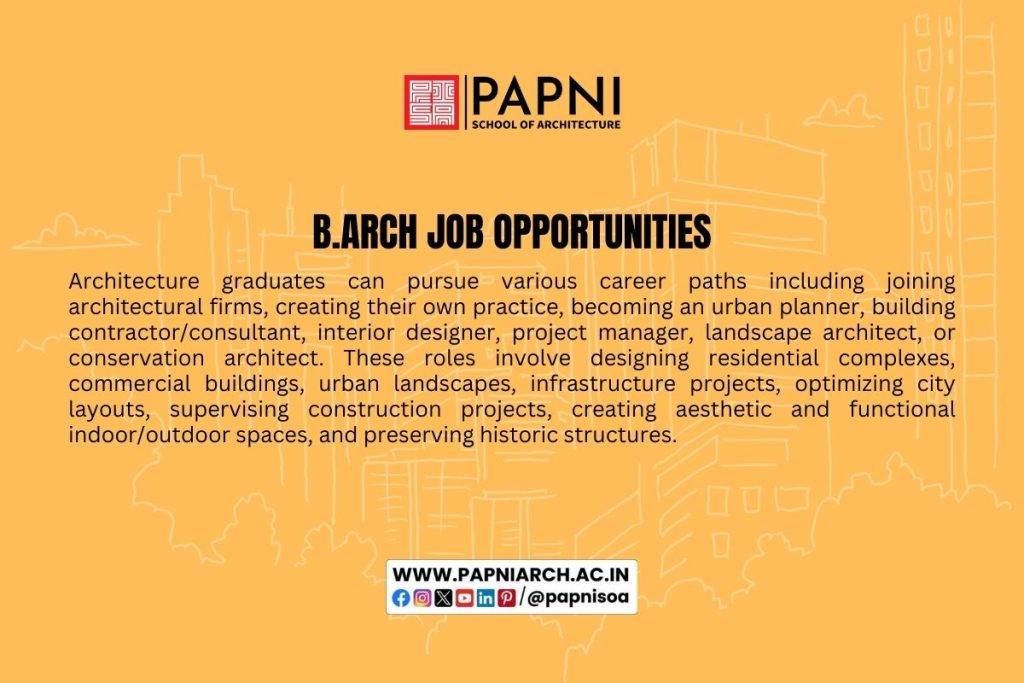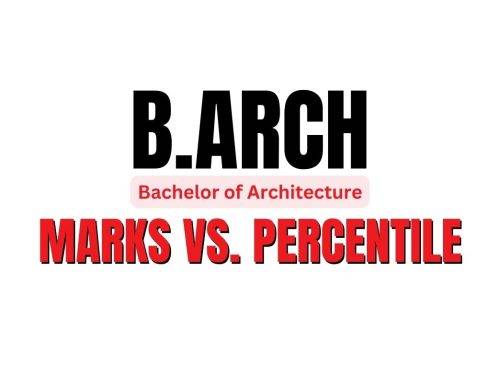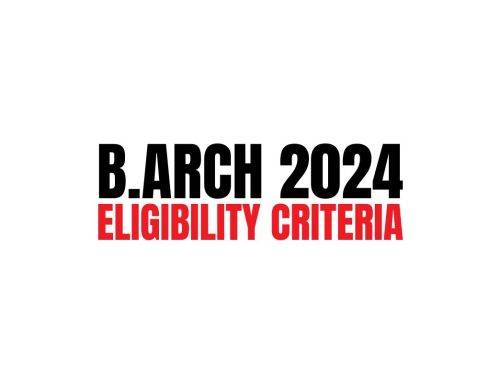Are you considering a career in architecture? This comprehensive guide to B.Arch covers everything you need to know, from eligibility criteria and admission process to course fees, syllabus, and career prospects. Whether you’re a prospective student or a parent seeking information for your child, this article offers valuable insights to help you make an informed decision about pursuing a B.Arch degree.
Table of Contents
I. Introduction:

A. Bachelor of Architecture (B.Arch) Overview:
The Bachelor of Architecture or B.Arch is a comprehensive degree program which imbues aspiring architectural students with rigorous training and expansive knowledge about fundamental aspects of architecture, building materials, aesthetic design and construction processes.
This undergraduate study typically takes five years to complete and includes coursework on architectural history, planning and design theory, building science, material studies, as well as practical sessions in the form of internships or studio work intended to equip the students with hands-on experience. It not only trains the students in technical facets but also fosters creativity so that they are capable of synthesizing aesthetically pleasing buildings that are sustainable as well.
B. The Necessity for Quality Architects in Society & Market:
In contemporary society architects stand instrumental in shaping our inhabited spaces assisting us to live better lives via designing user-centric structures fulfilling various purposes ranging from residential edifices to public infrastructures like hospitals, schools etc.
Good architecture imbibes beauty into our everyday surroundings while simultaneously ensuring safety, functionally optimised efficiency instigating a positive interaction between individuals & physical environments around them. Economically too – be it orienting buildings for natural sustainability elements such as sunlight & wind direction saving energy costs thus contributing towards ‘green environment’ OR adding real-estate value through striking designs thereby elevating market competition; benefits through quality architecture designs impact significantly.
Our increasingly urbanized world demands more quality architects who can address complex challenges including rapid urbanization issue countering space crunch with innovative solutions aligning architectural deliverables aesthetically yet functionally amidst socio-cultural contexts without compromising on eco-sensitive policies – thus reinforcing why we need exemplary architects today more than ever before!
II. B.Arch Architecture

A. Defining B.Arch:
B.Arch, an abbreviated form of the Bachelor of Architecture, is a comprehensive undergraduate degree that focuses on imparting knowledge and skillsets in architecture’s various aspects. This academic program aims to groom students into ethical and competent architects who can contribute creatively and cognitively to the built environment. The course’s title ‘Bachelor’ denotes the academic level while ‘Architecture’ indicates the subject matter which includes planning, design assessment, supervision & construction of buildings essentially integrating creativity with analytical & technical abilities.
B. Studying Architecture – An Overview:
Studying architecture is an enriching journey where students get to dive deep into designing structures harmoniously blending structural requirements with aesthetic appeal while being sensitive towards environmental factors & cultural parameters :
1.Core concepts involved in the course:
Architecture education revolves around core principles like spatial awareness (eg understanding how spaces interact within a specific layout), architectural drawing (technical sketching & 3D modeling), history of architecture (learning from ancient building techniques/styles from different civilizations), architectural theories (analyzing/understanding/critiquing past-present architectural ideologies towards creating well-founded reasoning for own proposals) , building science/materials study(design-relevant technical understanding eg specific heat conduction rates varying across brick versus concrete etc.).
2.Unique Components Distinguishing It From Other Streams :
Key components separating it from other conventional streams are:
a) Design Studio-based Learning: Teaching pedagogy pivots significantly on studio-based design exercises encouraging experiential learning fostering explorative problem-solving approaches creatively.
b) Combination of Artistic Creativity and Technical Knowledge: It synthesizes artistic creation seamlessly with scientific logic towards materializing visualized aesthetic designs soaring beyond mere analytical calculations – quite a unique aspect compared to regular engineering/science subjects.
c). Contextual Awareness: Architectural academia stresses too much explanation about socio-cultural-environmental contexts through which designs are envisioned, thereby reflecting socially relevant, culturally considerate and environmentally responsible building philosophies fetching it a distinctive academic flavor.
d). Cross-disciplinary Integration: It amalgamates concepts from variety of disciplines ranging from humanities (sociology/philosophy), sciences (physics/engineering) to arts(visual aesthetic/sculpture/painting) giving it a unique integrated knowledge platform diversity when compared to others.
III. B Arch Eligibility

A. Academic Eligibility Requirements:
1. High School Subjects Needed: Aspiring B.Arch students should have completed their 10 +2 school education from a recognized Board in India, ideally with the Science stream, including Physics, Chemistry and Mathematics as core subjects – due to the technical nature of architectural studies which require a foundational understanding of these subjects.
2. Minimum Marks or Grades Needed: The minimum percentile required can vary according to different colleges/universities but as per Council of Architecture (COA), India’s general requirement stipulates at least 50% aggregate marks in above mentioned science subjects combined along with minimum 50% overall aggregate marks in class 12th exam.
B. Entrance Exam Criteria:
To add another layer of qualification filtering, numerous institutes demand scores from specific entrance tests:
1. NATA (National Aptitude Test for Architecture): Administered by COA itself across nation multiple times a year typically involving Drawing Test & PCM test followed by cognitive skills test via an online mode; it focuses on measuring applicant’s aesthetic sensibilities, drawing skills and perception towards critical thinking expected from budding architects.
2. JEE Main Paper II Score: Another prevalent acceptance score is derived from the Joint Entrance Exam (JEE) Main conducted by National Testing Agency(NTA). Paper II specifically designed for B.Arch aspirants assesses candidates’ knowledge base through an elaborate Mathematics paper,intuitive Drawing Test & Aptitude section relating to architecture/engineering disciplines.
Note: Overall it is crucial to check each institute’s individual eligibility criteria since some may also entertain Diploma holders in relevant disciplines or International Baccalaureate Diploma passed out students after considering equivalence norms set up through Association of Indian Universities. Always recommended to keep an eye on frequent updates about date-submission deadlines either for applying various entrance exams or final admission forms filling as a procedural part of starting the architecture journey.
IV. Bachelor of Architecture (B.Arch) Admission Process

The procedure for gaining admission to a B.Arch program is rigorous and involves multiple stages; from taking competitive examinations, application submissions, to possibly even interviews or portfolio reviews. Here are the details:
A. Various Stages Involved in Securing Admission into a Good College/University:
- Entrance Exams Preparation Tips: Start studying early with a particular focus on Physics, Chemistry and Mathematics subjects as they form an essential part of entrance exams like NATA or JEE Mains Paper-II. At the same time, work on improving your drawing skills since these will be evaluated in exams such as NATA which emphasize perceptual drawing abilities assessing sense of proportion & perspective.
- Form Filling and Submission Deadlines: This stage involves applying online to desired Universities by filling out detailed application forms that request information regarding academic scores, achievements, personal details etc., before submitting them ahead of specified deadlines each institute provides on their official websites.
- Identification & Collaboration With Testing Centers: For instance NATA centres where test will happen as part of overall submission procedure need to be identified,collaborated with by way of filling corresponding forms mandatorily accompanying main application form.
- Choice Locking/Fee payment: Often we find counseling process post exam results where applicants are allowed choice locking options i.e specifying priority order within list provided universities for entry & paying fees hereafter locking choices.
- Result Declaration: Finally admission results declared basis candidate’s performance both in qualifying examination plus entrance exam including potential interview round if any.Thereafter concerned university sends invitation letters accordingly.
B. Interview Process:
While many Indian universities don’t carry this step some might have provision especially those offering design specializations demanding creative portfolio display section or face-to-face discussion session making sure aspirant’s aptitude towards architectural learning.Voluntary Personal statement accompanying application sometimes enables easy conversation initiation during interview process.
It’s key to remember that admission processes can often vary from institute to institute, and it is always prudent to verify details from their respective official portals. Consistent follow-up, meticulous scheduling & systematic preparation remains the ultimate mantras for navigating effectively through this intricate process resulting in admittance within satisfactory B.Arch program choice.
V. Overview of B.Arch Fees Structure

The cost of a B.Arch degree can vary widely based on the institution, geographical location, and additional expenses like accommodation & food in the case of residential campuses. Here is an outline:
A) Breakdown of Typical Fees:
The typical fee structure for a B.Arch degree includes several elements:
1. Entrance Exam Fee: The registration fee for entrance exams such as JEE Main or NATA, which generally ranges from INR 1,800 to 4,000 depending on exam type & category (General/SC/ST).
2. Tuition Fee: The major part of costs usually encompassing lecture fees,laboratory fees(wherever applicable),library access charges,sports facility usage etc Depends upon the reputation and geographical location but varies usually between INR 3 – INR 13 Lakhs across full five years duration.
3. Other miscellaneous charges: Could engulf anything starting from stationery/supplies charge into field trip expenses , fest participation money or alike not covered under regular tuition heads.
4. Hostel Fee: Considering residential candidates here,it incorporates primarily room rent,internet/electricity bill alongside mess fee covering daily meals supply ;usually within range between INR 50 K to lacs annually basis infrastructure quality involved.
B) Examination Department Fees:
This can include term-end examination fees charged separately by the affiliated university along with caution deposits incurred towards certain college facilities which remains refundable end course completion.
C) Training Workshop/Seminar Costs:
These might take place anywhere between mid-semester involving short-term specialized workshops arranged free/paid accordingly inviting expert architects/professionals enriching students’ educational exposure substantially.
1. Comparison Between Different Colleges/Universities
Fees will vary greatly depending upon different factors :
+ Government Aided / Private universities – Usually government facilitated architecture colleges/institutes levy nominal fees affordable by all compared much higher end fees applying in private institutes run autonomously under aided programs.
+ Location Advantage – Universities positioned more urbanscape influenced locales demands higher fees reflecting increased living costs around that city.
+ Infrastructure Differences – Enhanced infrastructural amenities like bigger workshop labs, vast libraries & equipped studios necessitate steeper costs justification.
2. Scholarship Opportunities to Support Tuition Fees
Many financial aid options exist easing the tuition burden off aspiring architectural undergraduates:
+ National/State Government Scholarships: Various state/countrywide scholarships are provided considering socio-economic disadvantaged sects or academically brilliant candidates supporting tuition/hostel expenses partly/completely.
+ Beneficiaries from Corporate CSR (Corporate Social Responsibility) activities where private organizations channel certain profit part towards education funds facilitating deserving candidates’ dream transmit into reality.
3. COA instituted scholarships for pursuing architectural studies nurturing young talents bringing valuable innovations field- wise .
4. Institutional Scholarships: Many reputed architecture institutions maintain separate scholarship provision recognizing in-house topper students affirming their seamless architecture study progression ahead.
Always suggested remaining active career counselling cells, educational forums or checking piece of information mentioned above helping creating a financially sound route towards acquiring architectural knowledge effectively.
VI. Essential Insights into the Core Curriculum – The B.Arch Syllabus

A meticulously designed curriculum is the driving force that validates the five-year integrated course of Bachelor of Architecture (B.Arch), alleviating a student’s theoretical know-how whilst fostering practical exposure to help comprehend architectural nuances. Below is a comprehensive delineation:
A) Snapshot: Subjects Subsumed Each Academic Year/Semester
1.Year One: The first year primarily acquaints students with foundational concepts, focusing on subjects like Architectural Design Fundamentals, Historiography & Evolution of Architecture and Elements in Structures.
2. Year Two: Building Construction and Material Science are introduced. Students get insight into climate-responsive design & emerging technologies as well.
3. Year Three: Students engage with thematic studies, studying about Urban Sociology & Economics while delving deeper into subjects like Building Services & Structural Design.
4. Year Four: A crucial year involving an intensive professional practice internship where students gain real-world experiences within architectural firms/organizations.
5. Final Year: Time to apply learned knowledge innovatively through Thesis Project execution showcasing personal architectural philosophy plus advanced elective courses offered suiting individual career specializations ahead
i) Theory Subject Details :
Theory forms the backbone providing overall penetrative understanding inculcating deep-rooted analysis skills conducting informed decisions :
1. Building Technology – Helps understanding technological aspects revolving constructions bringing sustainability controlling costs.
2. History of Architecture – Enriches with past architecture chronicles assisting trends appreciation contributing towards future innovations
3. Theory Of Structures – Deals in depthly building structures mechanical insights assisting calculations over structural stability ensuring safety
4. Humanities – Considers humanistic elements forming necessary societal backdrop influencing architecture inclusive various spatial aspects including vastu shastra or climatology considerations
5. Urban Planning and Housing – Familiarises urbanisation challenges,mass housing requirements developing informed solutions hereby .
ii) Practical Exposures/Lab Work Details:
Practical exposure incorporates hand-on experience understanding site-specificities & constructional nuances:
1. Sketching and Model Making – Encourages visual representation skills involving intricate architectural diagrams aiding design expression
2. Computer Aided Design (CAD) Lab – Brings familiarity towards digital technology involving software like AutoCAD, Revit, Sketchup etc which assists in accurate drawings development
3. Environmental Studies Lab – Involves analytical experiments relating different climatic conditions reflecting suitable materials/and building designs.
4. Participation in onsite Understanding – Crux of practical curriculum takes place interning inside industry gaining real time exposure working on live projects.
5. Town planning Projects – Requires modified urban strategies proposals accommodating key landscape or population considerations hinging upon local governmental norms effectively.
Systematic amalgamation of theory supported by practical undertakings forms a critical two-way channel assisting teaching pedagogies making B.Arch graduates competent professionals ready tackling architecture world multilayered demands.
VII. Unveiling Career Avenues Post-B.Arch Graduation
Navigating through numerous opportunities that emanate after acquiring a B.Arch degree unlocks the potential to both shape your career path and make a significant impact in the field of architecture and design.
i) Job Opportunities Accessible Post-Completion of Course:

1. Architect: You can join architectural firms or create your own practice designing residential complexes, commercial buildings, urban landscapes or infrastructure projects.
2. Urban Planner: Under city councils or planning departments leveraging architectural proficiency towards optimizing city layouts ensuring sustainable facilities proliferation.
3. Building Contracting/Consultant: You can venture into the business side working as a contractor involving bidding, budgeting, site supervision and liaison work with various parties associated with building construction.
4. Interior Designer: If you have an affinity for creating aesthetic & functional spaces inside buildings,this role works dealing with every intricate detail right from colour palettes to space optimization through furniture placement.
5. Project Manager: Architecture graduates can lead construction projects supervising everything right from project commencement until completion ensuring adherence to predefined parameters of quality, timeline & costs.
6. Landscape Architect: A specialized branch where architects involve developing efficient outdoor spaces like public parks,golf courses etc considering local flora-fauna aspects intricately.
7. Conservation Architect: Specializing in refurbishing and preserving historic structures maintaining their original charm intact yet aligning modern amenities amidst them is another promising career stream.
ii) Higher Education Horizons Available for Graduates:

1. Masters in Architecture (M.Arch): An opportunity to specialize deeper within specific architecture genres like Landscape Architecture,Urban Design,Sustainable Construction etc
2. Masters in Urban And Regional Planning (MURP): For those driven towards comprehensive planning at macro level integrating several architectural elements cohesively it’s an excellent choice.
3. Postgraduate Diploma Programme: In advanced architectural conservation/Patrimony management/Environmental Design etc.
4. M.Phil/Ph.D. in Architecture: For those who aim to indulge in research opening avenues into teaching, consulting , writing or evolving new paradigms challenging existing norms overall.
5. MBA‘s with Construction/Real Estate/Infrastructure Management Specializations are increasingly getting popular offering upper-hand understanding business aspects of architectural industry fitting graduates comfortably in lead roles as Project Managers/Directors and alike.
The journey post B.Arch is exciting but requires strategic foresight .Whether it’s gaining professional experience or further specializing in a chosen area, the architecture path encompasses both creative explorations and technical implications amalgamation shaping aesthetic yet functional futures.
VII. Conclusion
i) A Roadmap Through Inspirational Architecture:
Architectural education, which could be seen as a profound confluence of art, science, and technology, shifts beyond boundaries by challenging perceptions while tremendously enlarging your horizons. The dynamic industry is in constant flux seeking out innovation and sustainability. Your creativity can give shape and solidity to people’s dreams, thereby sculpting skylines across countries.
Remember, architecture isn’t a profession; it is a calling where every project inclines towards sending a thoughtful message about time and space. Do you have an inventive spirit? Are you eager to imbue the earth with sustainable structures that impact societal life positively? If the response echoes ‘yes,’ tread confidently upon this path – let your agility ignite extensive transformations throughout built environments.
ii) Reiterating The Value Proposition of B.Arch Degree:
In conclusion, pursuing a Bachelor’s degree in Architecture serves up exciting possibilities for students keenly fascinated about merging craftsmanship with scientific principles. Spanning five years dedicated practical cum theoretical curriculum polishes comprehensive designing abilities incorporating aesthetical elements amidst functionality considerations.
An architectural career offers diverse roles from conceptualization within studios until on-ground execution bringing paper designs alive seamlessly- offering self satisfaction incomparable! Intricate understanding buildings inside-out covering future needs sustainability-wise forming prime highlight lays down exceptionally impactful careers influencing society large.
Moreover if inclined towards higher studies it further refines knowledge expanding vision over deeper aspects closely touching lives architecturally . With job opportunities spanning across public sectors or private corporations or setting own consultancies – each set up brings novel challenges fulfilling professional aspirations effectively .
Thus B.Arch education’s merits outweigh intensive academic journey ongoing sailing through intellectually stimulating spaces filled profound realizations wholeheartedly inviting aspiring architects onwards rewarding yet responsible journeys ready crafting tomorrow’s infrastructural needs conscientiously !!
FAQ’s
- Provides a comprehensive education in principles and practice of architecture
- More in-depth exploration of design, construction, history, theory, and technology
- Prepares graduates for professional registration and practice in architecture
- Offers combination of theoretical knowledge and hands-on experience
- May allow for more career opportunities and higher pay
- Can offer more flexibility for graduate studies in related fields
- Builds a solid grounding in topics like architectural history and urban design
- Accredited degree often required to sit for state licensing exams
B. Arch, or Bachelor of Architecture, is an undergraduate degree program in the field of architecture. It prepares students for a career as a professional architect by providing them with knowledge and skills in design, construction, and building science. This degree is highly sought after due to the increasing demand for sustainable and innovative design solutions in the modern world.
To gain admission into a B.Arch program, students are typically required to take an entrance exam such as the National Aptitude Test in Architecture (NATA) or the Joint Entrance Examination for Architecture (JEE Arch). These exams test a student’s aptitude in areas such as mathematics, drawing, and general knowledge. They are designed to assess a student’s readiness for the rigorous coursework and hands-on learning that is required in an architecture program.
No, admission to B.Arch programs in India requires a valid score in NATA or JEE Main.
- Indian Institute of Technology (IIT) Roorkee
- National Institute of Technology (NIT) Calicut
- Indian Institute of Technology (IIT) Kharagpur
- School of Planning and Architecture (SPA), Delhi
- Chandigarh University (CU), Chandigarh
- Papni School of Architecture (PISA), Tamil Nadu
- JEE Main B.Arch admissions are based on the performance in the entrance exam.
- Eligibility typically includes completing 10+2 with a minimum percentage, often 50% for general candidates.
- JEE Main Paper 2 is specifically for B.Arch admissions and includes Mathematics, Aptitude, and Drawing sections.
- The final admission is through JoSAA counseling based on JEE Main (Paper 2) scores.
- Some institutions may also accept scores from other entrance exams like NATA (National Aptitude Test in Architecture).
- Eligibility Criteria
- Complete 10+2 or equivalent with Mathematics as a subject.
- Some colleges also accept 10+3 Diploma holders with Mathematics.
- The candidate should meet the minimum percentage criteria, which varies across institutions.
- Entrance Exams
- National Level Entrance Exams
- NATA (National Aptitude Test in Architecture)
- JEE Main (Paper 2) for B.Arch.
- State Level Entrance Exams
- Many states in India conduct their own entrance exams for architecture admissions.
- University Level Entrance Exams
- Some universities may have their own entrance exams and criteria.
- National Level Entrance Exams
- Application Process
- Register and appear for the respective entrance exams.
- Fill out the applications for the colleges or universities you are interested in.
- Counselling and Admission
- After the entrance exam results are declared, the counselling process begins.
- Participate in the counselling sessions, which may include document verification and seat allocation.
- Some colleges may conduct personal interviews or portfolio reviews.
- Merit-based Admission
- Some private colleges may also offer seats based on the merit of the qualifying examination.
- Architecture Aptitude Test (AAT)
- For admissions to architecture programs at the Indian Institutes of Technology (IITs), candidates must qualify for the JEE Advanced and subsequently clear the AAT.
- Documentation
- At the time of counselling, candidates must produce educational certificates, entrance exam scorecards, identity proofs, etc.
- Enrollment
- Upon successful allocation of a seat and verification of documents, candidates must enroll in the college and pay the requisite fees to confirm their admission.
The syllabus for B.Arch entrance examinations like NATA and JEE Main Paper 2 typically includes topics related to drawing and observation skills, sense of proportion, aesthetic sensitivity, and critical thinking ability that are related to architecture. For detailed syllabus, candidates should refer to the respective exam’s official website.
- Average fee range: INR 2,00,000 to INR 8,00,000 per annum.
- Government college fees: INR 1,00,000 to INR 2,50,000 approximately.
- Private college fees: INR 1,00,000 to INR 6,00,000 approximately.
- Hostel fees range: INR 7,000 to INR 1,60,000 approximately.
There are a variety of scholarship opportunities available for B. Arch students in India. Many universities and private organizations offer scholarships based on academic merit, financial need, or other criteria. It is important for students to research and apply for these opportunities to help ease the financial burden of pursuing their education. Additionally, some government schemes such as the National Scholarship Scheme and state-specific scholarships are also available for B.Arch students in India.
For more details on scholarship details by Papni school of Architeture – Apply now
The eligibility criteria as stated specify that candidates must be of Indian origin. International students should refer to specific university guidelines as the eligibility may vary for international admissions.
Yes, candidates must have qualified the National Aptitude Test in Architecture (NATA) or JEE Main Paper 2 with a valid score for B.Arch admissions.
Yes, a valid score in either NATA or JEE Main Paper 2 is acceptable for B.Arch admissions.
Yes, there is usually a centralized counseling process for allocation of seats in various colleges based on the scores of the entrance exams.
The B.Arch curriculum typically includes subjects related to architectural design, theory, history, technology, and practice. The exact subjects can vary by institution.
Career Prospects After B.Arch
- Urban Planner
- Landscape Architect
- Restoration Architect
- Interior Designer
- Artist
- Research Architect
- Building Surveyor
- Construction Manager
- Estates Manager
- Estimator
- Historic Buildings Inspector/Conservation Officer
- Architectural Engineer
- Architectural Historian/Journalist
- Art Director
- Building Contractor
- Lighting Designer
- Project Manager
- Teacher/Professor
- Entrepreneur
- Real Estate Development
- Government and Private Sector Architect
https://papniarch.ac.in/b-arch-colleges-coa-approved/







